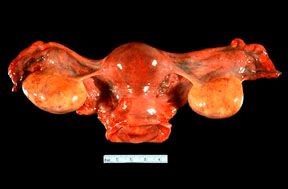The female gonads are the ovaries. The ovaries are oval in shape, each measure approximately 3-4 cm long and weigh about 5-8 grams. Ovaries are located close to lateral pelvic wall, behind the broad ligament and anterior to rectum. They are connected to the lateral pelvic wall by suspensory ligament, to the broad ligament by the mesovarium, to the uterus by the utero-ovarian ligament.
 Histology
Histology• Germinal epithelium (mesothelium) – the outermost layer of the ovary
• Tunica albuginea –dense connective tissue surrounding the ovary (underneath the germinal epithelium)
• Cortex- contains numerous ovarian follicles
• Ovarian Medulla(or Zona vasculosa of Waldeyer) - contains blood vessels, lymphatic vessels, and nerves.
• Corpus luteum - derived from the ovarian follicles
• Corpus albicans - are the remnant of the corpus luteum
Type of Cells• Follicular cells
• Granulosa cells
• Oocytes
Function• They function to store and release egg cells (ova or oocytes).
• The ovaries also serve as a site of production and secretion of the female sex hormones.
Hormones Secreted by the Ovaries:• Estrogens – originate in the ovarian follicles, promotes female sexual characteristics
• Progesterone – formed in the corpus luteum and also in placenta, prepares the uterus for pregnancy
Reference:http://en.wikipedia.org/wiki/Ovary
http://psychology.wikia.com/wiki/Ovary
http://www.free-ed.net/sweethaven/Science/Biology/AnatomyPhysiol/Human01_LessonMain.asp?iNum=1208
http://www.pathologyoutlines.com/ovary.html#primary


